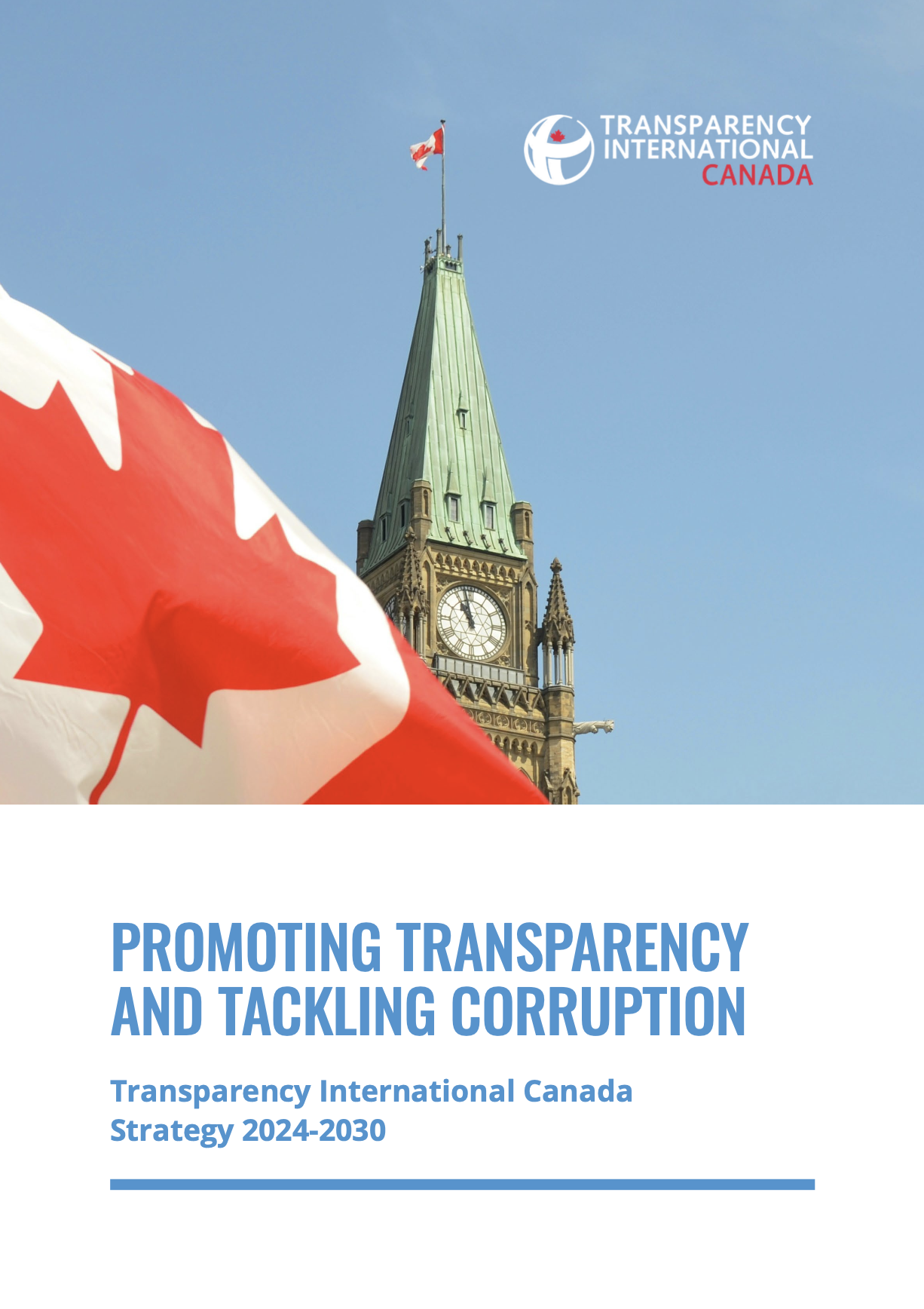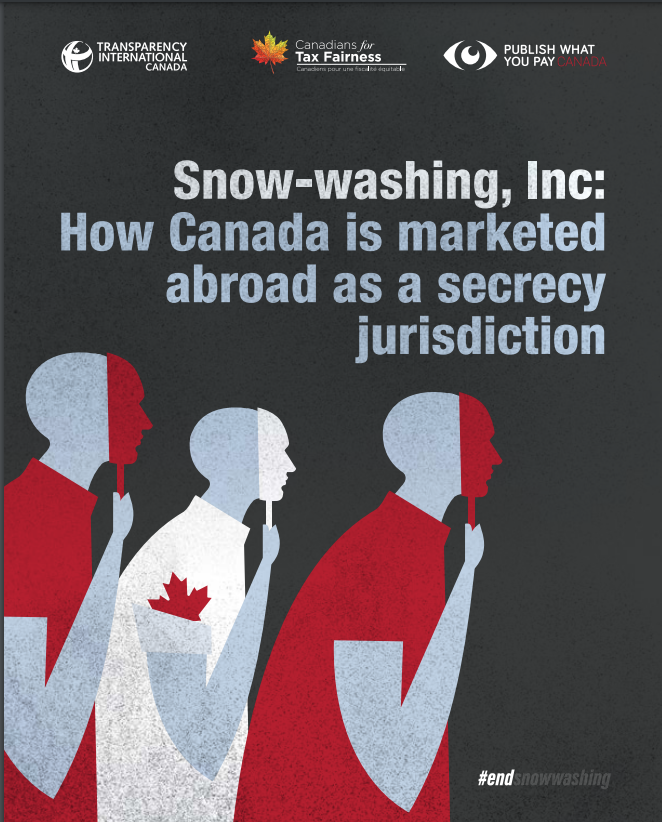Strategy 2030 Stratégie
WHITE PAPER: Bringing a "Failure to Prevent" Offence to Canada
Read our new whitepaper on bringing a 'failure to prevent' offence to Canada to help counter corruption!
The OECD phase IV report stated that Canada's corruption enforcement was "exceedingly low", party due to the difficulty of detecting, investigating and prosecuting corruption in Canada. A 'failure to prevent' offence shifts the compliance burden to ensure that organization's have in place proper policies and procedures to prevent corruption, or they can be prosecuted for failing to do so.
Consultation on Strengthening Canada's Anti-Money Laundering and AntiTerrorist Financing Regime
On behalf of Publish What You Pay Canada, Transparency International Canada, and Canadians For Tax Fairness, we are pleased to submit feedback as part of Canada’s consultations to Strengthen its Anti-Money Laundering and Anti-Terrorist Financing Regime
Transparency of Environmental Assessments in Newfoundland and Labrador
This report discusses the challenges and opportunities associated with resource development in the province and the importance of transparency and accountability in the environmental assessment (EA) process.
With its future growth largely tied to offshore oil and gas, mining, and electric power generation from hydro and wind, Newfoundland and Labrador’s economic engines must advance with due regard to the EA process.
Establishing a Canadian Financial Crime Agency
Transparency International (TI) Canada releases its white paper on how Canada can develop a national financial crime agency.
Over the last two decades Canada has been criticized at home and internationally for its weak enforcement record in response to money laundering, foreign bribery, sanctions enforcement, and other criminal offences that could fall under the broad category of ‘financial crime’.
Through mandate letters and budgets, the Government of Canada has stated its intention to establish a Canadian Financial Crimes Agency (CFCA). In the 2023 federal budget, the government indicated that the CFCA should focus on investigations, enforcement, convictions, and asset seizures, specifically related to money laundering.
TI Canada’s full submission to the OECD’s Phase Four monitoring of Canada
OECD Phase 4 Submission
On Friday, March 31, TI Canada made a submission to the Organization of Economic Co-operation and Development’s (OECD) open call for contributions for Canada’s fourth phase of monitoring the implementation of the OECD Anti-Bribery Convention.
Canada’s phase three of monitoring was held in 2010 with the report published in 2011.
Canadian Corporate Data Transparency Index
Blanchiment d’argent – Le Canada, une juridiction prisée pour son opacité
Le Canada jouit d’une réputation mondiale positive en tant que démocratie stable, riche qui est dotée d’un État de droit solide. Pourtant, elle figure également parmi les juridictions les plus opaques en ce qui concerne la propriété des sociétés et des partenariats. Les informations relatives à la propriété ne sont pas publiques et les entités peuvent être créées et contrôlées depuis l’étranger. Certaines entités ne sont soumises à aucune obligation de déclaration ou d’imposition nationale, mais elles peuvent détenir des comptes bancaires et conclure des contrats. Ces structures sont particulièrement attrayantes pour les mauvais acteurs qui ont besoin d’une couverture pour leurs méfaits. Par conséquent, le Canada est devenu un endroit très prisé pour constituer des sociétés écrans.
Up to the Task? The state of play in countries committed to freezing and seizing Russian dirty money
This study assesses how well countries leading multilateral efforts to freeze and seize kleptocrats’ assets are equipped to deliver on these objectives. The comparative analysis covers eight countries: Australia, Canada, France, Germany, Italy, the Netherlands, the United Kingdom (UK) and the United States (US). A majority of these have also set up national task forces to implement sanctions, but most are focused on coordination. Only the US’s KleptoCapture task force has a distinct asset tracing mandate.
Transparency International found that insufficient transparency measures – that kleptocrats have abused for decades – allow the elites to keep their assets out of authorities’ reach. What’s more, patchy regulation of private sector intermediaries and under-resourcing compromise authorities’ ability to act on available evidence and track down illicit assets. Unless reforms are passed, most countries will also face significant legal challenges when it comes to confiscating and eventually returning these assets to the victims of corruption.
Le résumé du rapport en français est disponible ici.
Snow-washing, Inc: How Canada is marketed abroad as a secrecy jurisdiction
Canada has long been perceived as weak on financial crime. Encouragingly, however, the federal government recognizes these risks, and in April 2021 proposed to implement a public beneficial ownership registry over the next four years. This is a significant development, and it is vital that the provinces and territories now follow suit. It is time for a unified approach to deter money laundering and transnational organized crime and address the threat snow-washing poses to Canada’s hard-fought reputation for integrity and fairness.
No Reason to Hide: Unmasking the Anonymous Owners of Canadian Companies and Trusts
Transparency and Accountability Concerns for Virtual Consultation: The Case of Mining Project Environmental Assessments in Canada
As an example of the challenges and opportunities that virtual consultations present for environmental assessment (EA) governance, domestic and international evidence indicates that the pandemic restrictions are being used to fast-track projects without the possibility of in-person gatherings. Nevertheless, stakeholders and researchers also report that actors are adapting to the pandemic conditions. Thus, virtual engagement and consultation, monitoring, auditing and consulting practices have become common practice, especially in the environmental assessments (EAs) of mining projects. This discussion paper outlines the online consultation context, its transparency challenges and opportunities, particularly related to Indigenous community consultation processes, and what actions should be deployed to ensure a meaningful virtual engagement and transparency and accountability in EA processes of mining projects in the Canadian context.
Survol des accords de réparation au Canada
Bien que les accords de réparation soient une procédure légale que peuvent utiliser les procureurs canadiens depuis l'automne 2018, aucun cas résolu à ce jour n’utilise ce nouveau mécanisme de règlement. La présente note d’information vise à donner un aperçu des principales caractéristiques des accords de réparation en droit canadien, tout en identifiant certaines lacunes du régime et les incertitudes qui persistent.
Implementing a Publicly Accessible Pan-Canadian Registry of Beneficial Ownership: Legislative and Technical Options
We make the following recommendations for public officials to consider as they study implementation of a pan-Canadian publicly accessible registry of beneficial ownership: Examine making a beneficial ownership registry separate from existing jurisdictional corporate registries, but using complementary information; Collect standardized beneficial ownership data across jurisdictions that follows global data collection standards; Legislate a registry through the Proceeds of Crime (Money Laundering) and Terrorist Financing Act (PCMLTFA); Work towards incorporating digital IDs into the registry for data verification; and Develop a registry as a centralized architecture.
Overview of Remediation Agreements in Canada
Although remediation agreements have been available to prosecutors in Canada since the fall of 2018, to date no case has been resolved through the use of this new settlement mechanism. This document is intended to provide an overview of the main features of the remediation agreement regime, while identifying areas of continued uncertainty.
Integrating Gender in Environmental Assessments: An approach to increase transparency and accountability in the mining sector
In this briefing note, we examine if, and to what extent, gender is integrated in Canadian regulations. To do this, we first briefly review the mining industry’s gendered impacts and EAs. Then, we mention different frameworks that have been developed to include gender in EAs. We explain in deeper detail Gender-Based Analysis Plus (GBA+), as this framework developed by the Government of Canada will likely be the most frequently used in Canada due to federal requirements. Finally, we analyze Ontario, British Columbia and the Yukon Territory’s EA legislation and guiding documents as they relate to gender, as well as the federal Impact Assessment Act. This analysis was done using the Gender Integration Continuum, which provides terms to classify programs, policies and initiatives in terms of their levels of gender inclusiveness. To do this evaluation, we have examined whether the jurisdictions included gender as a matter to be considered in EAs and whether they included gender requirements for consultations.
Opacity: Why Criminals Love Canadian Real Estate (And How to Fix It)
To determine the prevalence of opaque ownership in Canada’s largest housing market, we analyzed more than 1.4 million residential property transactions in the Greater Toronto Area (GTA) dating back to 2008. Because there is no data on nominee owners and trusts, our analysis focused on properties owned through corporate entities.
Accountable Mining Canada National Report A Risk Assessment of the Environmental Assessment Process
TI Canada assessed the approval of mine closure plans within the Province of Ontario (Ontario). Therefore, the report does not consider all the remaining approval processes within the mining cycle, such as obtaining mining tenure and environmental impact assessments. Furthermore, the report does not assess the Ontario Environmental Bill of Rights process for public participation. As it is a pilot project, the report has focused only on the Ontario Mining Act, and the approval of mine closure plans prescribed therein. In the assessment, two main risks were identified and prioritized by the researchers. These risks highlight uncertainty about the likelihood and impact of events that could have a negative effect on the lawful compliance and ethical awarding of mine closure plans. The first is the risk of manipulation of negotiations with Indigenous Peoples, and the second is that certain steps of the award process are not publicly knowable. Both risks point to a lack of transparency in the award process.16
Mining for Sustainable Development National Report
This briefing note discusses how criminals can hide their identity behind secret companies, which harms the Canadian economy, particularly Small-Medium Enterprises (SMEs). We propose a policy mechanism to deter bad actors from using secret companies to facilitate the proceeds of crime. This policy solution would alleviate administrative and regulatory due diligence costs for SMEs.























